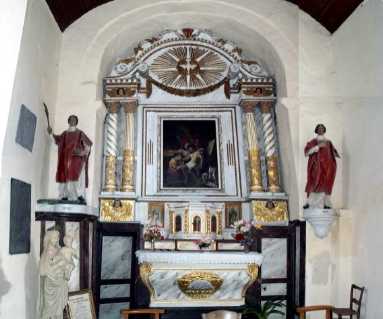This is the altar of the little chapel of Saint Gervais in Briouze. The chancel and apse are all that remains of the priory church that was generously endowed by the de Braose family. In 1866-7 the nave, tower and transepts were demolished. The chapel is now listed as a beautiful example of eleventh century Norman architecture. In about 1073 William de Braose first offered the church to the nearby Abbey of Lonlay which, to his dismay, abandoned Briouze soon afterwards. The Abbot refused to accept the conditions of the grant and Lonlay lost a valuable benefactor. William then gave the church to his mother, Gunnor. She placed the church in the hands of secular clerks but by 1080 a scandal had come to light. The clerks were found to be leading wicked lives and they were ejected. Soon the monk Goscelm from the Benedictine Abbey of Saint Florent in Saumur, Anjou had begun building a new stone church at Briouze. His great toil won the appreciation of William de Braose, who had been disappointed by earlier failures. He had probably visited the abbey and admired it during one of the Conqueror's campaigns. On Friday, January 31, 1080 the King confirmed William de Braose's grant of the church in Briouze to Saint Florent, along with the churches of Ecouché, Sevray and Courteilles. The Abbot of Saint Florent established a small priory at Briouze. He agreed to William de Braose's condition that should the new priory prosper, it would one day become an abbey. (Sadly, it never did.) Saint Florent also received rich grants from the de Braose Rape of Bramber in Sussex, England. By 1080 Lonlay Abbey had realised what a valuable gift it had lost. Abbot Hugh of Lonlay took the case to William the Conqueror's court at Caen, claiming that William de Braose had broken his solemn promise to make the gift of his lands to Lonlay. The Abbot lost the case but the grievance was not forgotten. In 1093 Abbot Ranulf of Lonlay took the case to Robert Duke of Normandy, the Conqueror's son. The Duke was holding an important council at Bonneville. William de Braose and the monks of Saumur put their case to the Duke and gave evidence to show the dishonesty and greed of the claims made by Lonlay. Abbot Ranulf and his monks made a hasty and shameful retreat, disappearing without informing the Duke. This infuriated Robert. His officials had wasted much time preparing for the spurious case and he demanded compensation from Lonlay. Shortly afterwards William de Braose's priory church was dedicated to the fourth century martyrs, Saints Gervais and Protais, who were associated with Saint Ambrose in Milan. On Sunday, December 11, 1093 a dedication ceremony was attended by Serlo, Bishop of Sées, and other clergy, barons and witnesses. It was a dramatic scene. The Bishop was just about to celebrate Mass at the altar when William de Braose forced his unwilling son Philip to confirm the grants to Saint Florent. William was assisted by his nephew, William de Crenella. They took a dagger from a monk named Armellus and placed it on the altar. While the family gifts to Saint Florent were recited at William de Braose's command, all three placed their hands on the dagger to confirm their solemn oath. (Sources: The Chartulary
of Sele, edited by L F Salzman, Cambridge, 1923 and
Calendar of Documents preserved
in France, Ilustrative of the History of Great Britain &
Ireland, edited by J H Round,
1899.)
|
© Lynda Denyer, Steyning,
2000 |



